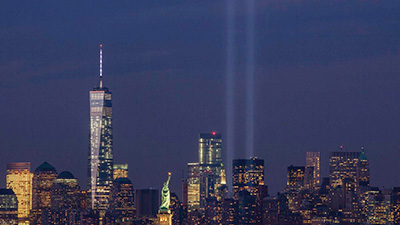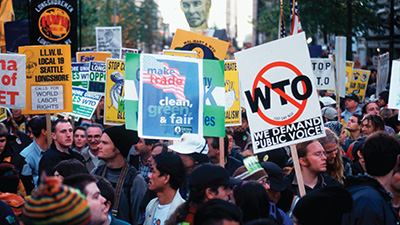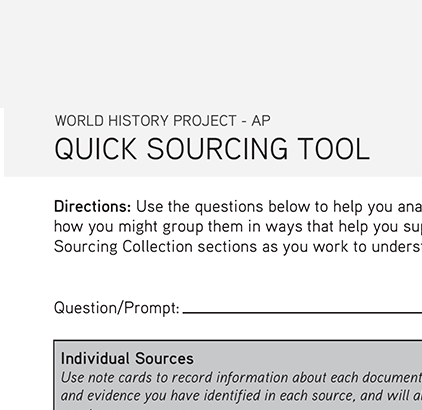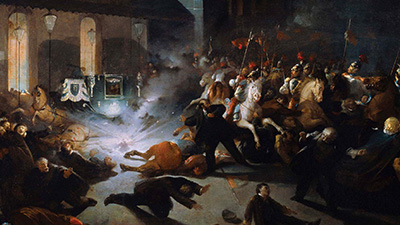Update ahead! This course will be updated soon. See what's changing.
Unresolved Conflicts
Driving Question: How have the tensions of globalization sparked new conflicts?
The acceleration of change and the intensification of global connections have created new tensions. A variety of social movements and international institutions seek to reform the systems of globalization and chart a course into the future. Other groups seek to upend the status quo. As these visions for the future collide, the result has often been conflict.
- Investigate how different groups have responded to globalization.
- Work on informal writing skills and formulate an answer to the Unit Problems.
- Use the historical thinking skill of claim testing to analyze the effects of globalization.
-
Guiding Questions
-
Note: For more detailed directions on completing the three close reads below, refer to the Three Close Reads – Introduction activity.
Skim
Before you read, you should quickly skim the article, by looking at the headings of each section and the charts. Read the questions below as well, so you know what to look for when you read!
Key Ideas
- What did the United States have to do with the Khmer Rouge genocide in Cambodia?
- What group of people did the Iraqi government, under Saddam Hussein, subject to a campaign of mass killing?
- What evidence does the author provide that propaganda played a role in the Rwandan genocide?
- What groups were involved in the Rwandan genocide?
- What evidence is there to suggest that religion played a role in the Bosnian genocide and continues to play a role in the ongoing Rohingya genocide?
Evaluate
- Respond to the question posed by the author: “If the common language of the international community is indeed human rights, and genocide continues to happen, what does that say about human rights and the collective morality of our global community?”
- Why do you think the macro and micro levels of human interaction meet in a way that allows for thousands and even millions of people to murder each other? Is it a matter of big ideas or small ones?
-
Guiding Questions
-
Note: For more detailed directions on completing the three close reads below, refer to the Three Close Reads – Introduction activity.
Skim
Before you read, you should quickly skim the article, by looking at the headings of each section and the charts. Read the questions below as well, so you know what to look for when you read!
Key Ideas
- What question did Americans ask after the attacks and what answer did many come up with?
- Why is it inaccurate to blame the 9/11 attacks on “Islam”?
- What is the “Clash of Civilizations” argument, and why does the author say it was a problem after the 9/11 attacks?
- How is the 1979 Soviet invasion of Afghanistan related to the 9/11 attacks?
- What was Osama bin Laden’s larger strategy behind the attacks?
Evaluate
- The 9/11 attacks have a lot of surrounding causes and events. How might you reframe the narrative of these attacks using each of the three course frames?
- The author has a generally critical view of the American response to the 9/11 attacks. You might agree or you might disagree. Do you think the US strategy in the years after the attacks was effective? Why or why not?
Use the claim cards to evaluate several claims about globalization and our world today.
As you read the primary source excerpts in this collection, use the accompanying Quick-Sourcing Tool to guide your analysis.
-
Guiding Questions
-
Note: For more detailed directions on completing the three close reads below, refer to the Three Close Reads – Introduction activity.
Skim
Before you read, you should quickly skim the article, by looking at the headings of each section and the charts. Read the questions below as well, so you know what to look for when you read!
Key Ideas
- Why did anti-migrant protests happen in Europe after 2015?
- What country hosts the most refugees, and what did they receive for limiting illegal refugee migration into the European Union?
- How did nationalism shape governments’ approaches to dealing with refugees and migration in general?
- How did decolonization lead to an increase in refugees?
- What are some reasons that refugees migrate and seek refuge?
- Why do some nations, in particular wealthy nations, allow migrant workers to come into their countries?
- How did wealthy nations react to increasing refugee and labor migration?
Evaluate
- How do you think globalization has changed the ways that people have migrated in the last 100 years?
-
Guiding Questions
-
Note: For more detailed directions on completing the three close reads below, refer to the Three Close Reads for Graphic Bios – Introduction activity.
Observe
Skim the full comic, paying attention to things like prominent colors, shapes, and types of text and fonts. How do you know where to start and which direction to read? What’s in the gutters (the space between panels)? Who is the focus of the comic? What big questions do you have?
Understand
- Where was Islam Alhashel born and why did her family leave?
- Where did her family first find refuge, and how did they move onward?
- What were Islam’s experiences when they arrived in the United States?
- How does the artist use art and design to depict how Islam’s life was fractured, and then rebuilt?
Connect
- How does this biography of Islam Alhashel support, extend, or challenge what you have learned about how different communities have experienced globalization in the contemporary era?
-
Guiding Questions
-
Note: For more detailed directions on completing the three close reads below, refer to the Three Close Reads – Introduction activity.
Skim
Before you read, you should quickly skim the article, by looking at the headings of each section and the charts. Read the questions below as well, so you know what to look for when you read!
Key Ideas
- Why did the Zapatista Army of National Liberation attack government institutions in 1994?
- How do the Zapatistas see themselves as a continuity of a long history?
- What were Mexican government responses to the Zapatistas?
- What are the Zapatistas doing in Chiapas in an attempt to provide alternate, community-based services?
Evaluate
- How do you think a Zapatista supporter would describe globalization? Would you agree with their definition? Does the Zapatista example suggest that there are limits to the globalization process? Do you think the Zapatistas will successfully resist globalization in the long term?
- What does the Zapatista example tell us about change and continuity over long periods of time? What has the Maya experience of the past 500 years been, according to this article?
-
Guiding Questions
-
Note: For more detailed directions on completing the three close reads below, refer to the Three Close Reads – Introduction activity.
Skim
Before you read, you should quickly skim the article, by looking at the headings of each section and the charts. Read the questions below as well, so you know what to look for when you read!
Key Ideas
- Generally speaking, what is the goal of terrorism?
- What are some examples of terrorism before the twentieth century?
- What social transformations changed terrorism in the twentieth century? How did they change terrorism?
- How was most terrorism in the twentieth century different from how we think of terrorism today?
- What evidence does the author use to argue that we are too afraid of terrorism today?
Evaluate
- In this article, terrorism is treated as something that is very old but also as something that has transformed in the last century. Give one example each for how terrorism has changed or is changing as a result of transformations that we label “globalization.”











